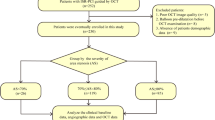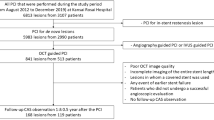Abstract
We determined the relevance between the TG-to-HDL-C ratio and stent restenosis. Ninety-nine patients with in-stent stenosis (ISR) who were admitted to An Zhen Hospital in Beijing between April 2014 and June 2017 were selected. At the same time, 122 patients with coronary stenosis <50% were selected. All patients were tested for TG, HDL-C, and TG/HDL-C ratio. Optical coherence tomography (OCT) can assess microscopic status in all ISR patients. The proportion of male and Diabetic patients were significantly higher for ISR. There were differences in the prevalence of cigarette smokers among the different tissue types, among which the layered tissue type accounted for the highest proportion. In logistic regression analysis the study showed that male, diabetes mellitus, and the TG/HDL-C ratio are risk factors for ISR. The ISR ROC was 0.725 based on the TG/HDL-C ratio diagnosis. It is related to the degree of coronary stenosis and effective in diagnosing in-stent stenosis in ISR.


Similar content being viewed by others
References
Mintz, G. S., Clinical utility of intravascular imaging and physiology in coronary artery disease. J. Am. Coll. Cardiol. 64(2):207–221, 2014.
Nakano, M., Vorpahl, M., Otsuka, F. et al., Ex vivo assessment of vascular response to coronary stents by optical frequency domain imaging. JACC Cardiovasc. Imag. 5:71–82, 2012.
Onat, A., Can, G., Kaya, H. et al., “Atherogenic index of plasma”(log10 triglyceride/high-density lipoprotein-cholesterol) predicts high blood pressure, diabetes, and vascular events. J. Clin. Lipidol. 4(2):89–98, 2010.
Yunke, Z., Guoping, L., and Zhenyue, C., Triglyceride-to-HDL cholesterol ratio : Predictive value for CHD severity and new-onset heart failure. Herz. 39(1):105–110, 2014.
Shim, Y. S., Baek, J. W., Kang, M. J. et al., Reference Values for The Triglyceride to High-Density Lipoprotein Cholesterol Ratio and Non-High-Density Lipoprotein Cholesterol in Korean Children and Adolescents: The Korean National Health and Nutrition Examination Surveys 2007–2013. J. Atheroscler. Thrombosis. 23(12):1334–1344, 2016.
Kasai, T., Miyauchi, K., Yanagisawa, N. et al., Mortality risk of triglyceride levels in patients with coronary artery disease. Heart. 99(1):22–29, 2013.
Davide, P., Cimino, G., Buccheri, D. et al., Recurrent in-stent restenosis, certainty of its origin, uncertainty about treatment. Int. J. Cardiol. 230:91–96, 2017.
Kundi, H., Korkmaz, A., Balun, A. et al., Is in-stent restenosis after a successful coronary stent implantation due to stable angina associated with TG/HDL-C ratio? Angiology. 68(9):816–822, 2017.
Yokoyama, K., Tani, S., Matsuo, R. et al., Increased triglyceride/high-density lipoprotein cholesterol ratio may be associated with reduction in the low-density lipoprotein particle size: Assessment of atherosclerotic cardiovascular disease risk. Heart Vessels, 2018. https://doi.org/10.1007/s00380-018-1247-9.
Murguıa-Romero, M., Jimenez-Flores, J. R., Sigrist-Flores, S. C. et al., Plasma triglyceride/HDL-cholesterol ratio, insulin resistance, and cardiometabolic risk in young adults. J. Lipid Res. 54(10):2795–2799, 2013.
Kang, H.-T., Yoon, J.-H., Kim, J.-Y. et al., The association between the ratio of triglyceride to HDL-C and insulin resistance according to waist circumference in a rural Korean population. Nutr. Metab. Cardiovasc. Dis. 22(12):1054–1060, 2012.
Ke, W., Zhao, J., Huang, H. et al., The association between triglyceride/high-density lipoprotein cholesterol ratio and all-cause mortality in acute coronary syndrome after coronary revascularization. PLoS ONE. 10(4):e0123521, 2015.
Farrell, S. W., Finley, C. E., Barlow, C. E. et al., Moderate to high levels of cardiorespiratory fitness attenuate the effects of triglyceride to high-density lipoprotein cholesterol ratio on coronary heart disease mortality in men. Mayo Clin. Proc. 92(12):1763–1771, 2017.
Kwon, Y.-J., Park, J.-W., Lim, H.-J. et al., Triglyceride to high density lipoprotein cholesterol ratio and its association with periodontal disease in Korean adults: Findings based on the 2012–2014 Korean national health and nutrition examination survey. Clin. Oral Investig. 5:1–8, 2017.
Sarwer, N., Sandbu, M. S., Ricketts, S. L. et al., Triglyceride-mediated pathways and coronary disease: Collaborative analysis of 101 studies. Lancet. 375(9726):1634–1639, 2010.
Hadaegh, F., Khalili, D., Ghasemi, A. et al., Triglyceride/HDL-cholesterol ratio is an independent predictor for coronary heart disease in a population of Iranian men. Nutr. Metab. Cardiovasc. Dis. 19(6):401–408, 2009.
Salazar, M. R., Carbajal, H. A., Espeche, W. G. et al., Use of the plasma triglyceride/high-density lipoprotein cholesterol ratio to identify cardiovascular disease in hypertensive subjects. J. Am. Soc. Hypertens. 8(10):724–731, 2014.
Tanaka, F., Makita, S., Onoda, T. et al., Predictive value of lipoprotein indices for residual risk of acute myocardial infarction and sudden death in men with low-density lipoprotein cholesterol levels< 120 mg/dl. Am. J. Cardio. 112(8):1063–1068, 2013.
Uthoff, H., Staub, D., Socrates, T. et al., PROCAM-FRAMING-HAM-SCORE-and SMART-risk score for predicting cardiovascular morbidity and mortality in patients with overt atherosclerosis. Vasa. 39(4):325–333, 2010.
Otakea, H., Shitea, J., Ikenob, F. et al., Evaluation of the peri-strut low intensity area following sirolimus and paclitaxel eluting stent implantion: Insignts from an optial coherence tomography study in human. Int. J. Cardiol. 157:38–42, 2012.
Malle, C., Tada, T., Steigerwald, K. et al., Tissue characterization after drug eluting stent implantation using optial coherence tomography. Arterioscler. Thromb. Vasc. Biol. 33:1376–1383, 2013.
Nagai, H., Ishibashi-ueda, H., and Fujll, K., Histology of highly echolucent regions in optial coherence tomography images from two patients with sirolimus eluting stent restenosis. Catheter Cardiovasc. Interv. 75:961–963, 2010.
Zhang, B. C., Karanasos, A., and Regar, E., OCT demonstrating neoatherosclerosis as part of the continuous process of coronary artery disease. Herz. 40:845–854, 2015.
Kim, J. S., Afari, M. E., Ha, J. et al., Neointimal patterns obtained by optial coherence tomography with specific histological components and neointimal proliferation in a swine model of restenosis. Eur. Heart J. Cardiovasc. Imag. 15:292–298, 2014.
Kim, J. S., Hong, M. K., Shin, D. H. et al., Quantitative and qualitative changes in DES-related neointimal tissue based on serial OCT. JACC Cardiovasc. Imag. 5:1147–1155, 2012.
Kufener, S., Cassese, S., Valeskini, M. et al., Long-term efficacy and safety of paclitaxel-eluting balloon for the treatment of drug-eluting stent restenosis: 3-year results of a randomized controlled trial. JACC Cardiovasc. Interv. 8(7):877–884, 2015.
Tada, T., Kadota, K., Hosogi, S. et al., Association between tissue characteristics assessed with optical coherence tomography and mid-term results after percutaneous coronary intervention for in-stent restenosis. Lesions: a comparison between balloon angioplasty, paclitaxel-coated balloon dilatation, and drug-eluting stent implantation. Eur. Heart J. Cardiovasc. Imag. 16(10):1101–1111, 2015.
Funding
No funding.
Author information
Authors and Affiliations
Corresponding author
Ethics declarations
Conflict of Interest
None declared.
Ethical Approval
The Institutional Ethics Committee of Beijing An Zhen Hospital approved the research protocol (No.2018022X).
Additional information
This article is part of the Topical Collection on Patient Facing Systems
Rights and permissions
About this article
Cite this article
Li, Y., Jin, P., Hou, F. et al. Association Between TG-to-HDL-C Ratio and In-Stent Stenosis Under Optical Coherence Tomography Guidance. J Med Syst 43, 4 (2019). https://doi.org/10.1007/s10916-018-1119-y
Received:
Accepted:
Published:
DOI: https://doi.org/10.1007/s10916-018-1119-y




